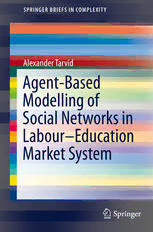Table Of ContentSPRINGER BRIEFS IN COMPLEXITY
Alexander Tarvid
Agent-Based
Modelling of
Social Networks in
Labour–Education
Market System
123
SpringerBriefs in Complexity
EditorialBoardforSpringerComplexity
H.Abarbanel,SanDiego,USA
D.Braha,Dartmouth,USA
P.Érdi,Kalamazoo,USAandBudapest,Hungary
K.Friston,London,UK
H.Haken,Stuttgart,Germany
V.Jirsa,Marseille,France
J.Kacprzyk,Warsaw,Poland
K.Kaneko,Tokyo,Japan
S.Kelso,BocaRaton,USA
M.Kirkilionis,Coventry,UK
J.Kurths,Potsdam,Germany
A.Nowak,Warsaw,Poland
H.Qudrat-Ullah,Toronto,Canada
L.Reichl,Austin,USA
P.Schuster,Vienna,Austria
F.Schweitzer,Zurich,Switzerland
D.Sornette,Zurich,Switzerland
S.Thurner,Vienna,Austria
SpringerComplexity
Springer Complexity is an interdisciplinary program publishing the best research
and academic-level teaching on both fundamental and applied aspects of complex
systems—cutting across all traditional disciplines of the natural and life sciences,
engineering,economics,medicine,neuroscience,socialandcomputerscience.
Complex Systems are systems that comprise many interacting parts with the
ability to generate a new quality of macroscopic collective behavior the manifes-
tations of which are the spontaneous formation of distinctive temporal, spatial or
functional structures. Models of such systems can be successfully mapped onto
quite diverse “real-life” situations like the climate, the coherent emission of light
from lasers, chemical reaction-diffusion systems, biological cellular networks, the
dynamicsofstockmarketsandoftheinternet,earthquakestatisticsandprediction,
freewaytraffic,thehumanbrain,ortheformationofopinionsinsocialsystems,to
namejustsomeofthepopularapplications.
Althoughtheirscopeandmethodologiesoverlapsomewhat,onecandistinguish
the following main concepts and tools: self-organization, nonlinear dynamics,
synergetics, turbulence, dynamical systems, catastrophes, instabilities, stochastic
processes,chaos,graphsandnetworks,cellularautomata,adaptivesystems,genetic
algorithmsandcomputationalintelligence.
ThethreemajorbookpublicationplatformsoftheSpringerComplexityprogram
are the monograph series “Understanding Complex Systems” focusing on the
various applications of complexity, the “Springer Series in Synergetics”, which
is devoted to the quantitative theoretical and methodological foundations, and the
“SpringerBriefs in Complexity” which are concise and topical working reports,
case-studies,surveys,essaysandlecturenotesofrelevancetothefield.Inaddition
tothebooksinthesetwocoreseries,theprogramalsoincorporatesindividualtitles
rangingfromtextbookstomajorreferenceworks.
Moreinformationaboutthisseriesathttp://www.springer.com/series/8907
Alexander Tarvid
Agent-Based Modelling
of Social Networks
in Labour–Education
Market System
123
AlexanderTarvid
FacultyofEconomicsandManagement
UniversityofLatvia
Riga,Latvia
RigaBusinessSchool
RigaTechnicalUniversity
Riga,Latvia
ISSN2191-5326 ISSN2191-5334 (electronic)
SpringerBriefsinComplexity
ISBN978-3-319-26537-7 ISBN978-3-319-26539-1 (eBook)
DOI10.1007/978-3-319-26539-1
LibraryofCongressControlNumber:2015956179
SpringerChamHeidelbergNewYorkDordrechtLondon
©TheAuthor(s)2016
Thisworkissubjecttocopyright.AllrightsarereservedbythePublisher,whetherthewholeorpartof
thematerialisconcerned,specificallytherightsoftranslation,reprinting,reuseofillustrations,recitation,
broadcasting,reproductiononmicrofilmsorinanyotherphysicalway,andtransmissionorinformation
storageandretrieval,electronicadaptation,computersoftware,orbysimilarordissimilarmethodology
nowknownorhereafterdeveloped.
Theuseofgeneraldescriptivenames,registerednames,trademarks,servicemarks,etc.inthispublication
doesnotimply,evenintheabsenceofaspecificstatement,thatsuchnamesareexemptfromtherelevant
protectivelawsandregulationsandthereforefreeforgeneraluse.
Thepublisher,theauthorsandtheeditorsaresafetoassumethattheadviceandinformationinthisbook
arebelievedtobetrueandaccurateatthedateofpublication.Neitherthepublishernortheauthorsor
theeditorsgiveawarranty,expressorimplied,withrespecttothematerialcontainedhereinorforany
errorsoromissionsthatmayhavebeenmade.
Printedonacid-freepaper
SpringerInternationalPublishingAGSwitzerlandispartofSpringerScience+BusinessMedia(www.
springer.com)
Preface
Most of us would like to have a job that would support both physical well-being
through providing enough income and psychological well-being reflected in high
satisfaction with life. Unfortunately, not all jobs are like that. A sizeable part of
thesocietyconsiderstheirjobsasinappropriatefordifferentreasons,startingfrom
severeworkingconditionsandendingwiththeacquirededucationand/orskillsnot
beingusedinthejob.Thishasanegativeimpactontheirphysicalandpsychological
well-being.Anotherpartofsocietyisnotemployedatall,eitherseekingjoborbeing
inactive,whichtypicallydoesn’tmakeone’slifecomfortable.
Not only we as individuals are interested in the jobs we find appropriate for
ourselves.Whethermostofusareabletofindthemisalsoofrelevancetofirmsand
policy-makers. Firms are increasingly caring about the level of job satisfaction of
theiremployees,becauseitaffectstheproductivityofthelatterand,ultimately,their
decision to stay or quit the job. Policy-makers care about it, because poor quality
of employment, meaning large rates of employee–job mismatch, unemployment
or inactivity, increases their chances to fail re-elections and lose their jobs and, in
extremecases,leadstocivilunrest.
Among the most important prerequisites of successful employment are knowl-
edge and skills, which come from education and experience. Using the language
of economists, the most efficient allocation of individuals across jobs is when the
characteristics of the former match those required in the latter. Otherwise, the
individual is mismatched by having more or less education and/or skills than the
jobrequires.Researchshowedthatworkinginajobwheretheacquirededucation
orskillsarenotusedhasconsiderablenegativeeffectsonbothphysicalwell-being
(e.g.lowersalariesandslowercareer)andpsychologicalwell-being(e.g.higherrisk
ofdepressionandlowerjobsatisfaction).
On a macro level, this result brings attention to the coordination between the
educationmarketandthelabourmarket.Lackofsuchcoordinationwasrepeatedly
noted by many, including the World Economic Forum [296], which classified
structuralunemploymentcausedbyeducationandskillsmismatchasaglobalthreat.
This coordination may be improved in three ways, depending on which of the
twomarketsisviewedasmoreimportantandwhichasthesourceoftheproblem.
v
vi Preface
One way is to blame the education system that is preparing too few graduates in
somefieldsofstudyandtoomanyinothers.Thosewhoholdthisviewproposeto
restructuretheeducationsystemsothatitproducesonlythegraduatesdemandedby
employers[56,128].Anotherwayistoblamethelabourmarket,whichisunableto
takeadvantageoftheexistingsupplyofgraduates.Ifthisisthecase,itisproposedto
restructurethelabourmarketsothatthecountrybenefitsfromthespecialistsithas
[199].Stillanotherwayistotakeabroaderviewandunderstandthereasonsofthe
existingimbalances,whichmightwellexistbecauseofmisalignmentofeducation
and labour markets. Then these issues should be addressed and the links between
thetwomarketsshouldbeimproved[53].Thiswouldleadtobothmarketsworking
morecloselytogetherandbeingbetteradaptedtocurrentandfuturedevelopments.
Clearly,thisthirdwayappearstobethemostbeneficial.
This leads to the necessity of considering the labour market together with
the education market as one system or labour–education market system (LEMS).
Education-related decisions of individuals affect their labour-market options and
outcomes, and labour-market outcomes of individuals affect education-related
decisionsofotherindividuals.ThisisthecoreofatypicalLEMSmodel.
The idea that education and labour markets should be modelled together is, of
course,notnew,andeconomistshavefrequentlyembodiededucationcharacteristics
of individuals into labour-market models. Usually, economists use mathematical
modellingtechniquesand,hence,havetoignoretheeffectsonindividuals’decisions
fromsocialnetworksformathematicaltractability.Atthesametime,thereisavast
bodyofempiricalevidenceconfirmingthatsocialnetworksareanimportantsource
of information for individuals and influence their decisions in both education and
labour markets. Should we really ignore this important element in our models of
LEMS?Certainlynotinallcases.
Agent-based modelling allows to overcome not only the inability of social
network modelling by standard mathematical economics techniques but also other
shortcomings of standard economic modelling. This book is about using agent-
based simulations to model LEMS with embedded social networks—more con-
cretely, individual behaviour in LEMS where individual decisions are affected by
socialnetworks.
Thebookiswrittenasaguidetousingagent-basedmodellingforthispurpose.It
doesnotcontainfullydevelopedmodels—soifyou’reinterestedinsuchexamples,
you’ll have to read the relevant articles, and this book references many of them.
Rather, it contains a set of proposals on how different aspects of LEMS models
should be constructed and an analysis of the approaches to their construction in
the available literature. It also does not contain examples of programming code in
a concrete agent-based modelling platform—programme listings that are included
arewritteninpseudocode,sothatyoucaneasilyimplementtheminyourpreferred
platform.Itisalsonotanencyclopaediaonindividualbehaviour(itwouldbemuch
thickerifitwere)—butitisacollectionoffactsandanalysesthatyoushouldknow
aboutandconsiderwhilebuildingyouragent-basedmodelofLEMS.
The book does not require you to be an expert in the field of agent-based
modelling, education market, labour market or social networks (even if you are,
Preface vii
I hope you’ll still find the book useful). I also hope that it will be interesting to a
widereadership,tobothundergraduatestudentsandexperiencedresearchers.
There are three main chapters in the book. Chapter 1 discusses the facts we
know about individual behaviour and the role of social networks in LEMS from
empirical literature, also noting theoretical support, where relevant. Then Chap.2
substantiatestheneedtoapplyagent-basedmodellingtostudyingLEMS,discussing
the benefits and drawbacks of this modelling method, and provides a step-by-step
guide to it. Finally, Chap.3 analyses how three large blocks of LEMS—education
market, labour market and social networks—can be constructed in an agent-based
model,basedonexistingliteratureandtheempiricalresultsdiscussedinChap.1.
Iwishyouapleasantreading.
Riga,Latvia AlexanderTarvid
Contents
1 SocialNetworksandLabour–EducationMarketSystem ................ 1
1.1 SocialNetworks.......................................................... 1
1.1.1 RequiredMinimumfromtheGraphTheory ................... 2
1.1.2 Creating,MaintainingandDissolvingSocialTies............. 3
1.1.3 StructureofSocialNetworks.................................... 6
1.2 IndividualBehaviourintheEducationMarket......................... 8
1.2.1 IndividualAspects:Ability,SexandPersonality............... 9
1.2.2 Social Environment: Family, Social Class
andSocialNetworks............................................. 11
1.2.3 MonetaryCostsandBenefits.................................... 12
1.3 IndividualBehaviourintheLabourMarket ............................ 13
1.3.1 MethodsofJobSearchandRecruitment ....................... 14
1.3.2 Overeducation.................................................... 15
1.3.3 QuittingtheJob.................................................. 19
2 ComplexAdaptiveSystemsandAgent-BasedModelling ................ 23
2.1 WhatIsAgent-BasedModelling?....................................... 23
2.2 WhytoUseAgent-BasedModelling... ................................ 25
2.2.1 ...forModellingComplexAdaptiveSystems? ................ 25
2.2.2 ...IfTraditionalEconomicModellingExists?................. 27
2.2.3 ...IfOtherSimulationMethodsExist?......................... 29
2.3 HowtoDoABM?........................................................ 33
2.3.1 FromGoaltoImplementation................................... 33
2.3.2 ParametrisationandCalibration:SettingParameters .......... 34
2.3.3 Validation:CheckingtheModel ................................ 36
2.3.4 RunningtheModel .............................................. 36
2.3.5 AnalysingOutputandItsSensitivity ........................... 37
2.4 LimitationsofABM ..................................................... 37
ix

